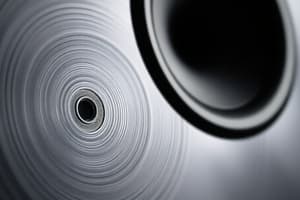Podcast
Questions and Answers
What is at the core of sound production?
What is at the core of sound production?
- Vibrations (correct)
- Pressure changes
- Frequency modulation
- Sound waves
Which of the following best describes how sound waves travel?
Which of the following best describes how sound waves travel?
- As vibrations of pressure (correct)
- Through light
- By heat transfer
- As electromagnetic waves
How does the amplitude of a sound wave affect the sound produced?
How does the amplitude of a sound wave affect the sound produced?
- It determines the pitch
- It governs the sound's loudness (correct)
- It affects the speed of sound
- It changes the medium of propagation
Which of these is an example of sound production from vibrating solids?
Which of these is an example of sound production from vibrating solids?
In what scenario would a vibrating liquid produce sound according to the text?
In what scenario would a vibrating liquid produce sound according to the text?
What fact about sound production distinguishes it from light production?
What fact about sound production distinguishes it from light production?
What type of sound production involves air molecules vibrating inside a confined space?
What type of sound production involves air molecules vibrating inside a confined space?
Which method of sound production involves strings being plucked or struck?
Which method of sound production involves strings being plucked or struck?
What produces sound waves in wind instruments like flutes or clarinets?
What produces sound waves in wind instruments like flutes or clarinets?
How do compressed gases like air produce sound?
How do compressed gases like air produce sound?
Which method of sound production involves vibrating membranes found in speakers or microphones?
Which method of sound production involves vibrating membranes found in speakers or microphones?
What happens when a pebble is dropped in a pool according to the text?
What happens when a pebble is dropped in a pool according to the text?
Flashcards are hidden until you start studying
Study Notes
Sound: Understanding Its Origins and Production
Sound is an essential aspect of our day-to-day lives, and yet, it's a phenomenon that's not easily defined. We hear it, we produce it, but how does sound originate and how does it travel through the world around us? To unravel this mystery, let's take a closer look at sound production, a fundamental aspect of understanding the physics behind sound.
Sound Waves
At the core of sound are vibrations. When an object vibrates, it creates pressure changes in the surrounding air, causing the propagation of a sound wave. These waves are oscillations of pressure, which can be visualized as peaks and troughs, traveling through the air or any medium that's elastic enough to transmit them. The frequency of these waves determines the pitch of the sound, while their amplitude governs the sound's loudness.
Sound Production: Vibrating Objects
Sound production primarily occurs when an object vibrates. This vibration can be the result of intentional actions, such as plucking a string on a guitar, or unintentional actions, such as a car door slamming shut. There are three main ways in which objects produce sound:
-
Vibrating Solids: When a solid object is struck, compressed, or set in motion, it will vibrate and produce sound. For example, a drumstick hitting a drum or a person clapping their hands.
-
Vibrating Liquids: Liquids, such as water or air, can also vibrate and produce sound when they're displaced by an object. For instance, when you drop a pebble in a pool, the ripples it creates are sound waves.
-
Vibrating Gases: Compressed gases like air can also vibrate, producing sound. For example, air flowing through a whistle or air being forced through a megaphone.
Sound Production: Vibrating Air
Sound production also occurs when air itself vibrates. This can happen when air is forced to move in and out of a confined space, such as a trumpet or a mouthpiece. The vibration of air molecules inside the confined space creates sound waves that travel outwards.
Sound Production: Vibrating Membranes
Another common method of sound production is through vibrating membranes, like those found in speakers or microphones. A speaker's membrane vibrates in response to an electrical signal, creating sound waves that travel outwards and are heard by listeners.
Sound Production: Vibrating Strings
Strings, such as those found in a guitar or piano, are another common method of sound production. When a string is plucked or struck, it vibrates and produces sound waves that travel outwards and are heard by listeners.
Sound Production: Vibrating Air Columns
Lastly, sound can be produced through vibrating air columns, such as those found in wind instruments like flutes or clarinets. Air inside the column vibrates when the player blows air across or into it, producing sound waves that travel outwards and are heard by listeners.
Understanding sound production allows us to appreciate the complexity and beauty of sound, and helps us to better understand its role in our daily lives. Whether we're listening to our favorite song or trying to decipher a distant conversation, the underlying physics of sound production plays a critical role in our experience.
Studying That Suits You
Use AI to generate personalized quizzes and flashcards to suit your learning preferences.




